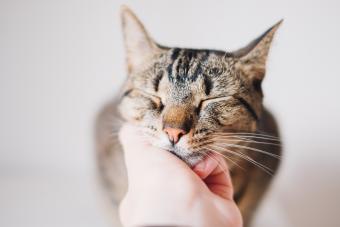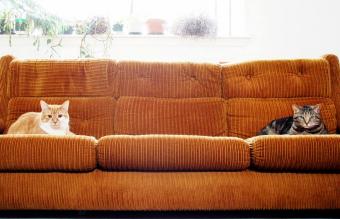
Have you ever wondered, why does my cat suck on blankets? Cats that suck on blankets may need to be examined by a veterinarian. This fabric sucking behavior sometimes appears out of nowhere and with no apparent reason. In order to manage this behavior, pet parents must identify the trigger.
Why Does My Cat Suck on Blankets?
This repetitive behavior may be the result of a medical condition. With that in mind, there are numerous causes of repetitive behaviors in cats, and it is not always boredom as one may think. Animal enrichment is often a solution, and depending on how compulsive your cat is, there are many ways to distract them from their favorite blanket.
Pica
Pica is when your pet eats non-food items, including blankets, shoes, and sweaters. Chewing or sucking on foreign objects results from poor social experiences, stress, anxiety, and inadequate weaning (before seven weeks). There is no cure!
Gastrointestinal Issues
Fabric sucking behavior is a compulsive eating issue that may be the result of a GI disorder. Licking also falls into this category.
Self-Soothing Mechanisms
If a cat is in acute or chronic pain, he may look to self-soothe with a blanket. Some breeds are more prone to this behavior.

Behavior May Increase if You Give It Attention
This behavior is complicated. Even though you may want to give your cat attention, telling your feline friend to stop the behavior could reinforce it. Instead, it is better to encourage a new activity in order to stop the repetitive behavior. Your cat may suck on the blanket for hours, which feeds into their compulsiveness.
If your cat looks for the blanket after mealtime, then make sure the area only has puzzle toys available. Skip the part where you get frustrated as it does no good and adds to your cat's stress.
Interrupt the Unwanted Blanket Sucking
Encourage your cats to chew or suck on safe items. Distracting your cat from the behavior with toys helps change the feline's mindset. A cat sitter is a great solution if you need help and are busy at work. Even if you need to see your vet, pet owners may want to consider "cat TV" to keep kitty distracted.
- Set up a cat tree next to the window.
- Add a few bird feeders to the deck outside.
- Engage your cat with novel toys they only see when this behavior happens.
- Puzzle toys are a big hit with most cats. Fill these with treats.
- Place cat grasses in areas where the fabric or blanket typically are located.
- A catio is an excellent addition to any home. Find a few DIY plans as these are affordable.
Your vet may need to provide anxiety medications to help even out the cat's mood, and enrichment is always part of the treatment plan.
A Vet Behaviorist Can Help
A general practitioner or vet behaviorist creates management, environmental, enrichment, and behavior modification plans for pet owners. Don't hesitate to contact a specialist.
Managing This Compulsive Behavior Helps
Avoiding the trigger is the first step. Try to identify the trigger and then counter condition your cat. Some cats grab their blanket after mealtime or when you arrive home from work, so have this timed perfectly.
- Put every blanket your cat has access to in another room.
- If this is impossible, create a safe place for your cat and supervise him with new toys as described above.
- Avoid the trigger. For example, switch up the mealtime routine after the blankets disappear.
- Don't let your cat practice the behavior and redirect your feline buddy to another safe activity.
Key Ways to Deal With Repetitive Behaviors in Cats
Stay on top of this behavior! Your cat's safe environment is their home. Set them up for success and check with your vet about possible medications. A vet behaviorist's treatment plan is vital for dealing with compulsive behavior, and you must follow all the steps. The treatment plan may not be easy, but you owe it to your feline buddy to ensure he's safe and happy.







